All about petrol cultivators
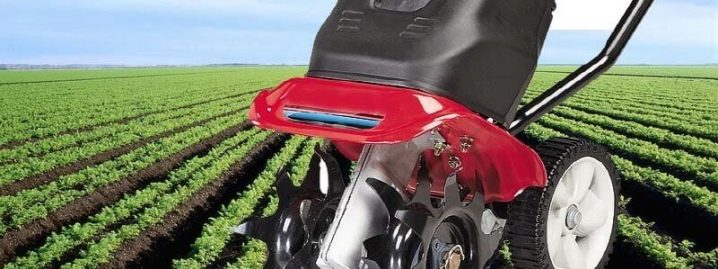
Plowing is the turning of the soil with an auxiliary tool. Gas-powered cultivators take a special place in this case, as they help to quickly and easily work on large areas and break larger particles into small ones. In order to choose the right cultivator for a summer residence, the user will need to more carefully understand the advantages and disadvantages of this type of technique.
Advantages and disadvantages
The petrol powered cultivator is an agricultural machine designed to plow the land. It works in softer and more difficult soils. It has a powerful motor that allows you to plow more areas in less time.
There are 3 types of cultivators:
- front;
- back;
- vertical.
Front clover motoblocks have teeth at the front and are the lighter version of the three presented. They are ideal for small gardens.
Machines where the cutting elements are located at the back is more difficult to work with. These machines are heavy and therefore require more force from the operator. In the design, the manufacturer can provide an electric starter, 4-stroke engine. The teeth can be switched for forward and reverse operation.


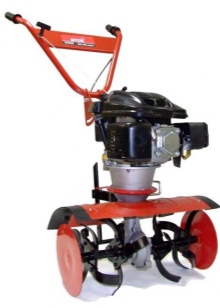
Of the advantages, it is necessary to highlight the most important ones, which make gasoline cultivators real helpers on land.
- It easily processes heavy soil, so such cultivators always do the job efficiently. Can be used on humus, loamy, clayey and even stony soils. In addition, depending on how large the garden is, you can choose a model with the appropriate capabilities.
- Ideal for large areas. These cultivators come with a more powerful engine and wider tines. Although the exact tine width and power will depend on the specific make and model, any cultivator will get the job done faster than a man on his own.
- An environmentally friendly 4-stroke engine that differs markedly from a 2-stroke engine.
- Longer prongs that have a long lifespan. They allow deeper tillage.
In this case, there were also negative aspects.
- These cultivators are usually larger and heavier. This makes them difficult to transport, store and maintain.
- More difficult for the operator to control. Although most models are equipped with additional functions, sometimes they only add complexity to the work. The use of such a cultivator requires experience and certain knowledge.
- Gasoline-powered equipment is more expensive, but it also has more opportunities.

Types and their characteristics
To buy a high-quality garden gasoline cultivator for plowing beds, you need to know and understand this technique. All models can be divided by engine type into two large groups:
- four-stroke;
- two-stroke.
It is the type of engine in the cultivator design that determines the cost of the unit by 60%. In a 4-stroke, the duty cycle consists of 4 cycles, hence the name. Accordingly, there are 2 of them in two-stroke. The main difference lies in gas exchange, that is, in how the air-fuel mixture is supplied and the exhaust gases are discharged.The 4-stroke engine has a special mechanism, it is responsible for the operation of the exhaust and intake valves, therefore such a motor is heavier and more difficult to maintain.

The two-stroke engine is very inferior in terms of economy, therefore, it is not so often used in the design of gasoline cultivators. Moreover, to create a fuel mixture, the user will have to independently mix gasoline and oil - in a four-stroke engine, all this is automated.
If we talk about comparing these two types of power units, then two-stroke ones have a higher liter capacity, as well as a specific one, but the latter have a gas distribution mechanism.
Environmental friendliness of engines should not be overlooked, since two-stroke exhaust is highly toxic. In terms of the amount of noise generated, four-stroke are predominantly distinguished, they also have a higher operating life, but two-stroke are gaining momentum faster.
When buying such a unit, the user should rely not only on the type of motor, but also on such technical indicators as the working width and immersion depth. The faster you want to work the area, the wider the grip of the cultivator should be, but in this case it should have more power.
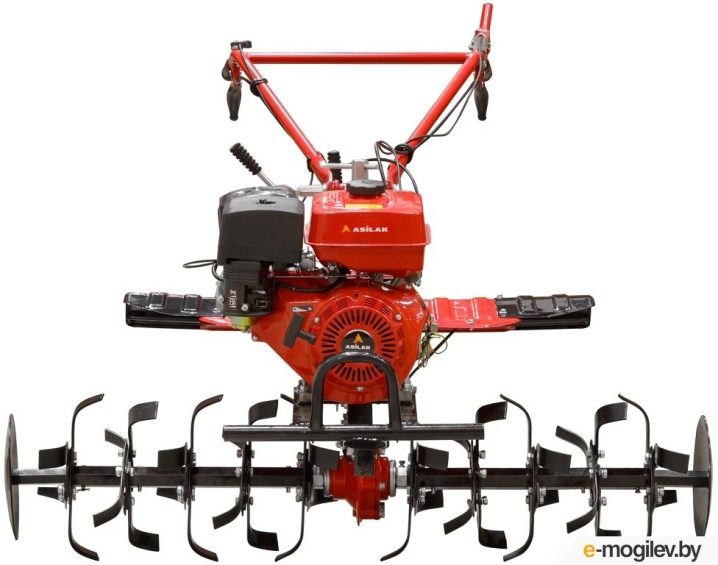
If we take into account productivity, then cultivators of the following brands are especially popular today:
- Elitech;
- DDE;
- MTD;
- Champion;
- Texas.
The weight and dimensions of the structure are also directly related to the power of the equipment. When choosing a good cultivator, the user will first need to decide what area of the site will have to be processed and on what type of soil to work.
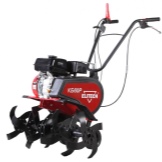
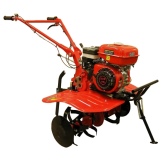

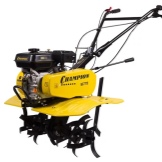
You will have to choose between the following models:
- lungs;
- medium;
- heavy.
Models that are large in weight are very difficult to operate, as they require power from the user.
Lightweight cultivators have low power (up to 4.5 horsepower only). They are ideal for small areas (up to 6 acres), since they have limited performance. Small dimensions and weight make it possible to use the equipment in a greenhouse or in the beds. The capture width of this technique is 20-30 centimeters. The knives sink 8 centimeters into the ground.
It is impractical to use such cultivators for cultivating virgin lands. Their power and weight are not enough to sink the cutter deep enough into the ground. The weight of the equipment does not exceed 40 kilograms. The cultivator easily fits into the trunk of a car - this is the advantage of the lightweight models.
Among other things, these models are quite maneuverable. Cultivators of this type are equipped with a worm gear, hence their short service life, since it is made of plastic.
Manufacturers advise to regularly check the lubricant on such units. More specifically, every 60 working hours. Of the minuses, one can also highlight the lack of reverse gear on most models of light cultivators. The equipment comes on sale with an additional mounted hiller, which helps to create furrows for planting seeds.
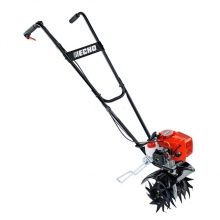
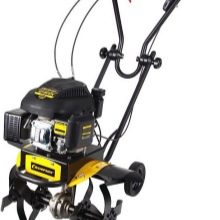
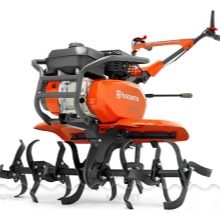
The category of medium cultivators includes models with up to 6.5 horsepower. Their weight does not exceed 60 kilograms, but even this is enough for maneuverability to decrease, and the quality of processing of heavy soil increases. Such cultivators do not jump, they immerse their blades to a depth of 250 mm, and their working width ranges from 400 to 850 mm.
If you select such a model for a summer cottage or garden, then it is desirable that there is a chain gearbox inside, since it has a longer service life, higher efficiency, there is a possibility of reverse. Precisely because this technique has more power, the operator has the opportunity to use more attachments. In the complete set, the manufacturer supplies a plow, a harrow, a hiller and a mower for the equipment.
Heavy cultivators are a separate category of equipment that exhibits up to 10 horsepower. Such units can be safely used on virgin soil, as well as to process large areas with their help. Their weight reaches 120 kilograms, in the design most often there is an opener or a special stop, which, during the movement of the equipment forward, plunges into the ground. The working width varies depending on the model and can be up to 12 meters.
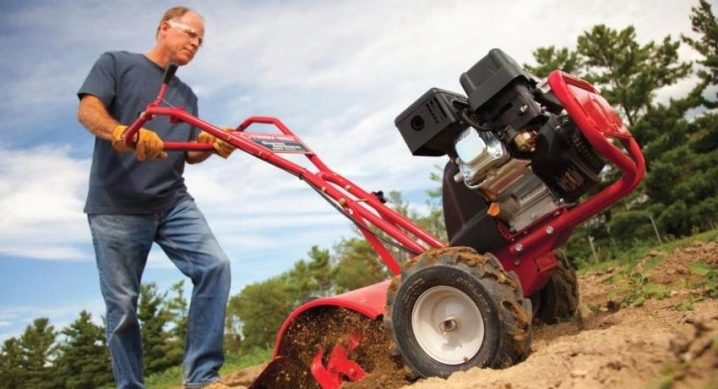
Popular models rating
Among the wide variety of offered models, one thing is for sure - there are manufacturers who have established themselves for many years as reliable suppliers of high-quality and easy-to-use equipment. Among them, in terms of reliability, Mac Allister, Stihl, Lifan, La Zappa, Salut stand out.
Lungs
The best cultivator in this category is FPTP123. It has a small weight and dimensions, easily fits in the trunk of a car, demonstrates a power of 3 horsepower. The weight of the structure is only 33 kilograms, so it is best to use this technique on well-groomed land. The immersion depth of the knives is 150 mm, and the width is 400 mm.
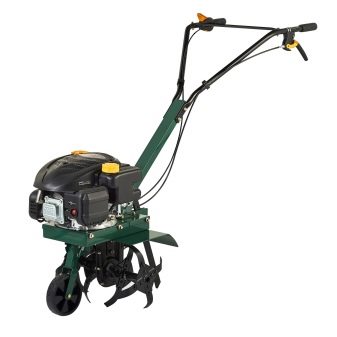
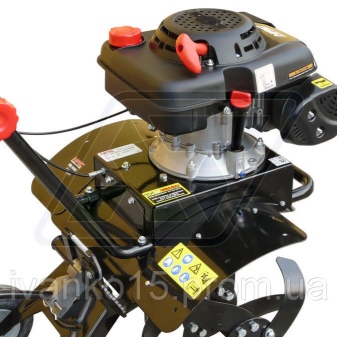
Echo technology is highly appreciated. In this case, the TC-210 model weighs only 9.5 kilograms, while the manufacturer demonstrates high build quality. The power of such a unit is only 1 horsepower, and the volume of the fuel tank is 0.5 liters. The width is 21 cm and the depth is 25 cm. Such a cultivator is ideal for working in a greenhouse or garden beds. Of the minuses, you can single out the high cost.
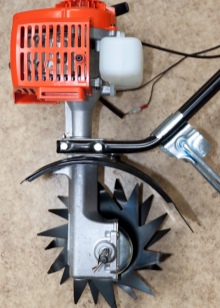
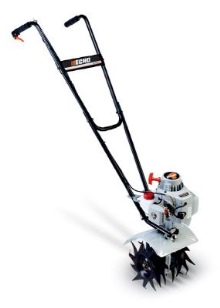
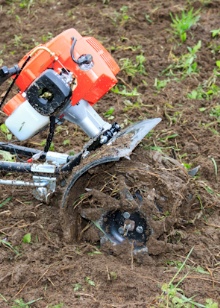
Middle class
Reliable Sterwins-2 have a capacity of 6.5 horsepower, while the weight of the structure is 69 kg. They work at the same speed, a 4-stroke engine is provided in the design. The technique can be used to handle large areas of difficult ground. Working depth - 32 mm.
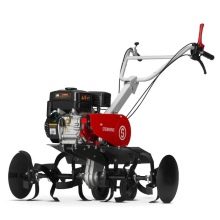
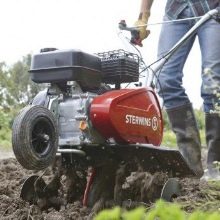

There is another model in this category that the user should pay attention to - the Remo XH360. Of the advantages, it is worth highlighting:
- compactness;
- maneuverability;
- small size.
Thanks to the perfectly matched dimensions, it is possible to use such a technique, the power of which is 4 horsepower, even in hard-to-reach places. The design includes six-blade cutters with a diameter of 270 mm. Soil coverage - 360 mm, depth - up to 260 mm.
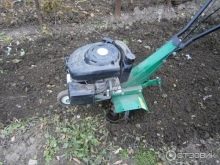
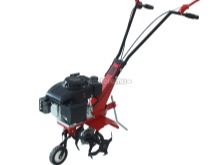
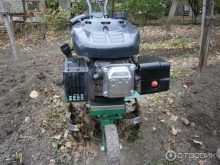
The Hammer RT-40A cultivator is also in the middle class, which demonstrates the power of the power unit of 4 horsepower, while the working width is 38 cm and the depth is 26 cm.The equipment is of high quality, since it is assembled in Germany, but it has a small volume fuel tank - 1.2 liters. With a total weight of 35 kilograms, such a cultivator can only work at one speed.

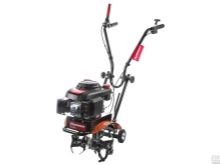

You should definitely pay attention to the Stiga Tellus 50 R, which can demonstrate 5.5 horsepower. The volume of the fuel tank is 1.5 liters, which is not so much, but the processing width is pleasing - up to 550 mm. The immersion depth is 330 mm, while there is a reverse, that is, the ability to move back.
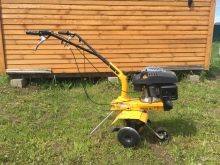
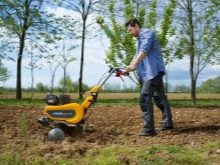
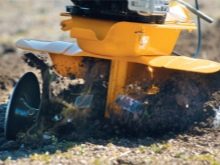
Heavy
The large-sized but relatively cheap MegArsenal WMA-900 weighs 85 kilograms when fully loaded. The width of the plowing area is up to 1.2 m, which means that it will be easier and faster to process a large area with such a technique. The immersion depth of the discs is adjustable from 15 to 30 cm. The capacity of the fuel tank, which is 6.5 liters of hot, cannot but please the user. Motor power - 7 horsepower.
The professional heavyweight Asilak SL-82B weighs 98 kilograms (and this is without additional attachments). Engine power - 7.5 horsepower, while the volume of the fuel tank is only 3.6 liters. The working width at the time of processing, which is 95 cm, cannot but please. The processing depth reaches 30 cm.
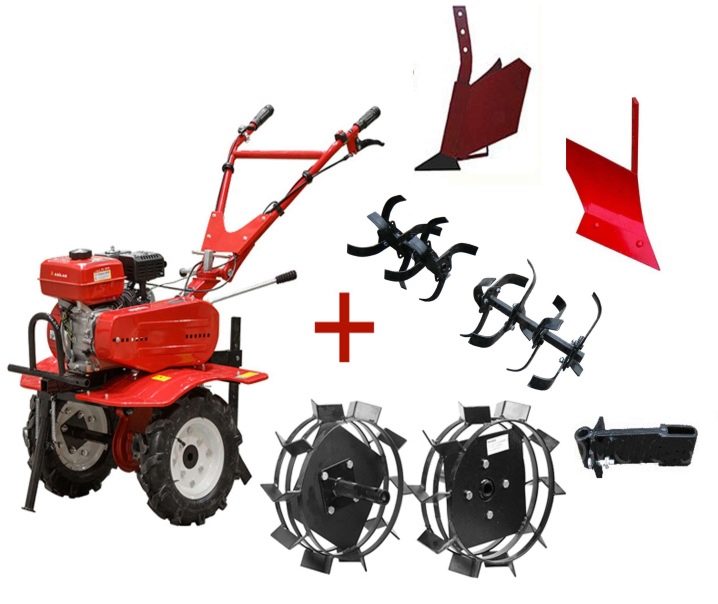
How to choose?
There are several factors to consider when buying a cultivator:
- performance;
- price;
- dimensions;
- appearance;
- performance;
- motor;
- gearbox type.
Performance is a fairly broad term, but refers to how well a given manufacturer's equipment performs at a given task. This concept includes: motor power, tooth configuration, working depth, various functions and much more.
There is a fairly wide range of sizes, so it is not easy to choose right away. There is a direct dependence of the size on the power, since the engines are strong and weigh more. Moreover, the choice of a person is not limited only to size - it is worth relying on reliability and brand reviews, the configuration of the teeth, since they have their own unique pros and cons.
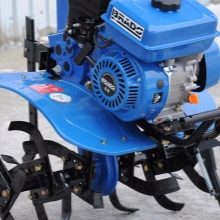
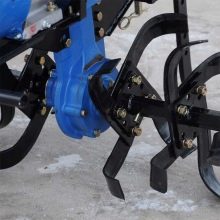

The price range between conventional cultivators and professional cultivators is very wide. The question of price plays an important role at the time of purchase. The user must understand whether the presented technique is worth the money that the manufacturer asks for, based on functionality, the possibility of "upgrade".
As for the appearance, here everyone decides for himself. Design can be a big problem for some, as a person accustomed to comfort will want the height-adjustable handle on the cultivator to be ergonomic, the housing protects the main components from dirt, and the existing openings do not clog grass and dirt.
Seeing how expensive a cultivator can be, the user will want it to have undeniable reliability and durability. This is achieved only through the use of quality materials and components. The efficient design allows you to hide or protect weak points in the cultivator.

The user should keep in mind that larger products can be quite bulky and heavy, so it is worthwhile to evaluate carefully their functions and accessories, which add to the comfort during use. It is desirable that the model provides for:
- ergonomic control panel;
- self-propelled mechanisms;
- large tires with good grip and turning radius;
- ease of maintenance or repair.
The main decision to make at the purchase stage is to choose a 2-stroke cultivator or a heavy-duty 4-stroke cultivator. Some models have a useful feature called reverse.
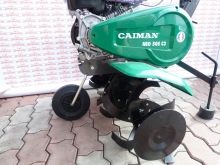
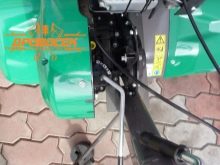
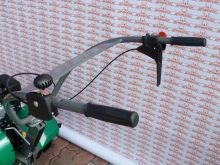
User manual
Sometimes the user has a question about why oil starts to pour out during the operation of the equipment. The answer is simple: don't pour too much of it into the barrel, especially when the surface is uneven. For checking the level, a special dipstick is supplied with most models.
Before setting up the cultivator, disconnect the spark plug wire from the spark. To adjust the steering wheel, 2 knobs on the inner surface are lowered. Be careful not to snag the throttle cable or switch wires. Tighten the handles to secure the handlebars in place.
To adjust the height, remove the handles and mounting bolts and reinstall them through the holes in the top or bottom of the handlebar. Do not forget to tighten the position.
The depth of the teeth is also adjustable by the operator. For this:
- stop the engine and disconnect the spark plug to avoid accidental starting;
- remove the pins from the bracket;
- move the support bracket up or down, the main thing is to align the holes in height;
- push the pin back through the hole.
It is very important to be able to fill and change the oil correctly when using a gasoline cultivator. The four-stroke engine can operate in conditions from + 40 to -15 degrees. High quality SAE 10w30 oil is used at low temperatures outside.
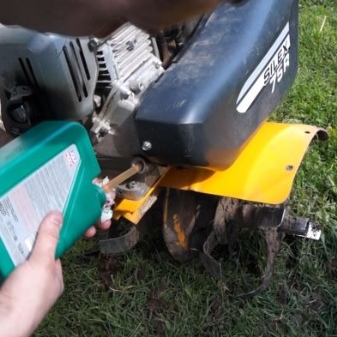
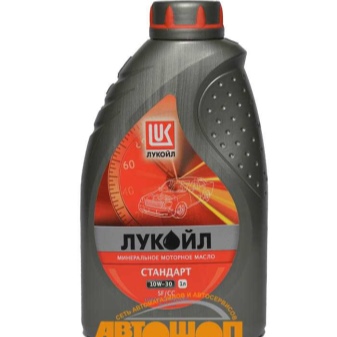
Unscrew the top of the bottle and remove the paper seal covering the opening. Place the cultivator horizontally on a flat surface. Remove the oil plug / dipstick from the crankcase. Pour the entire bottle of oil into the hole. Never add liquid to the fuel tank. Remove the tag from the plug.Wipe the surface if oil has spilled. Reinstall the plug.
The engine starts as follows:
- check the oil level in the crankcase;
- fill the fuel tank with fresh, clean, unleaded gasoline;
- for cold weather conditions (below 15 degrees), twitch the start lever, setting it up;
- the clutch is released slowly, some fuel should be visible in the fuel line;
- hold the steering wheel with one hand, pull on the starter, use your foot to hold the cultivator;
- tilt the device slightly back to remove the prongs from the ground at the start;
- when starting the engine, squeeze the throttle control to warm up the engine for 15 to 30 seconds.
If it is necessary to turn off the engine, release the hand from the throttle control.
When using this device, do not wear loose clothing or jewelry - be sure to wear glasses, long pants, boots and gloves. Before starting work, move the cultivator to the working area. The vehicle is transported by pressing on its wheels and pushing it forward. Never lift the unit while the engine is running.
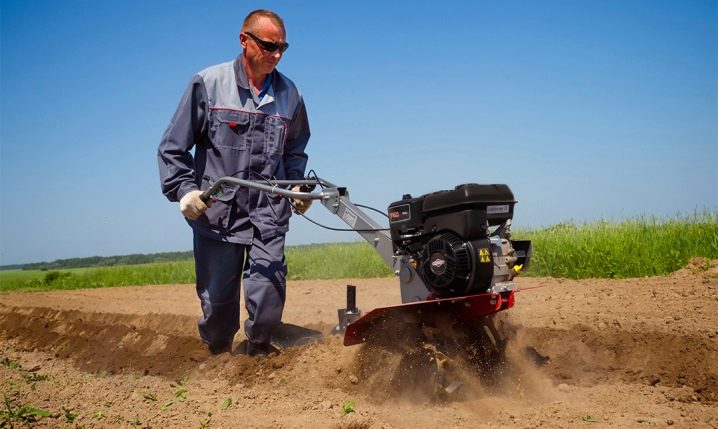
With the engine running, depress the throttle control to increase the operating speed. Holding the upper handle with both hands, slowly lower the cultivator until the tines sink into the ground - only then turn on the motor.
If the teeth are digging too deep or not deep enough, it is worth adjusting the wheel bracket. It should be remembered that when changing any settings, turn off the engine first.

Care
Cultivators undoubtedly help to keep the garden areas tidy with much less effort by the user. However, if you do not take care of the equipment correctly, then it will quickly cease to perform the assigned tasks.
It is always worth using the equipment in accordance with the manufacturer's instructions. Failure to do so can quickly shorten the life of expensive equipment. When buying a cultivator, you need to make sure that you are purchasing a model that has a solid construction, especially the handle.
Each time after work, the equipment must be thoroughly cleaned. Do not forget that soil particles, dirt and other elements left on the structure can destroy the metal surface. Some owners choose to use a garden hose and wire brush to remove dirt and debris that has adhered to the blades. The metal components of the cultivators must be kept clean to prevent damage caused by corrosion.
It is advised to lubricate all the main components before cleaning the cultivator for the winter so that they do not become rusty. The storage room should be dry and as warm as possible. The oil is drained like the fuel.
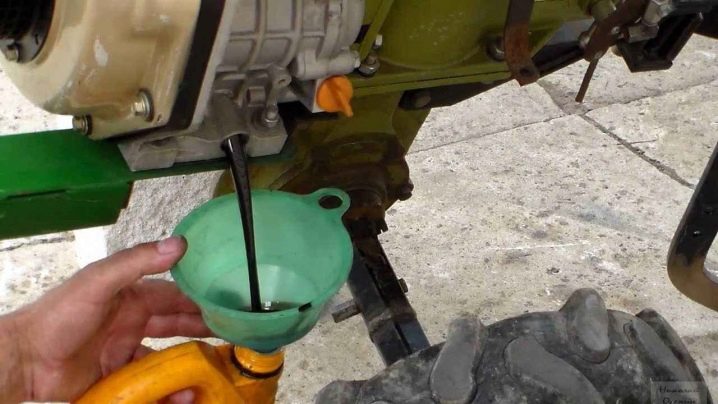
How to choose a cultivator for a summer residence, see below.



































































The comment was sent successfully.